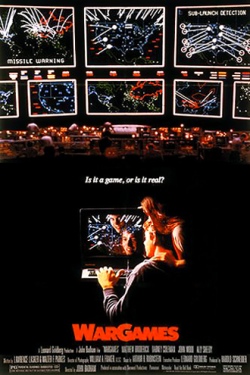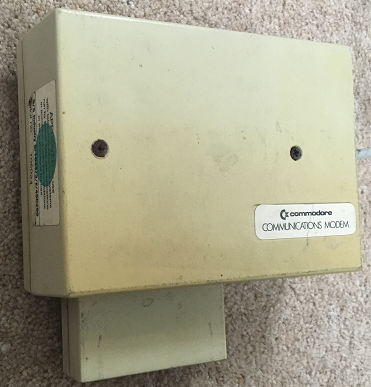Online services – a retrospective
Let the 80s and 90s computer nostalgia continue…
Between writing about how I learned to code, and watching the latest season of Halt and Catch Fire, I’ve been thinking about how the online services I’ve used over the years have shaped my view of the IT landscape.
WarGames
Like so many others my journey started with the 1983 classic WarGames. I came away from that movie desperately wanting an acoustic coupler (and free phone calls).

Prestel
I didn’t (yet) have a modem at home, but there was one in the school computer room, and we used it to connect to Prestel – British Telecom’s (BT) videotex service. Videotex was a big deal in the UK with BBC’s Ceefax and ITV’s Oracle, but they were broadcast only – Prestel was bi-directional. Prestel was also a big deal in the IT press due to the case against Steve Gold and Robert Schifreen for hacking Prince Philip’s account. They were charged with forgery because there were no hacking laws then.

Compunet
I never did get an acoustic coupler, but I finally got my hands on a modem with a promotion by Compunet where they gave away their C64 modem if you signed up to their service for a year. The modem supported the v.23 standard common with videotex services of 1200/75 baud – 1200 bits per second download and 75 upload (and yes – you probably can type faster than that). It also did v.21 300/300, which was generally better for uploading stuff to bulletin board systems (BBSs).

My main problem then was paying the phone bill. I’d get home from school and wait until 6pm for ‘off-peak’ calls, though that put me at odds with the rest of the household wanting to use our single landline for making and receiving calls, and it was still far from cheap. I think eventually we subscribed to BT’s ‘midnight line’ where it was possible to pay a fixed fee for unlimited calls between midnight and 6am – like many teenagers I became semi nocturnal – though the noise from my typing would sometimes result in angry shouts from my mum to pack it in and go to sleep.
Compunet had a great community, and I remember being able to find people who’d help me out with some of the crazy homebrew hardware projects I used to engage in at the time.
Kermit
Some of the companies and organisations I worked with on my evening/weekend jobs found that they needed to send files from office to office, so I created scripts that made the modems connect then transfer files with Kermit.
JANET/CIX
First year at University meant living in halls of residence, which in turn meant no access to a telephone point to use a modem. It didn’t matter much as I had my Amiga and PPC640 on hand. The fact that the University network was connected to JANET, and in turn the entire Internet eluded me at that time.
That all changed in second year. Project work meant burning the midnight oil, and a dialup connection to the University’s VAX cluster gave me a jumping off point into the Unix boxes of both the Electronics Department and Computer Science department, and from there I had worldwide connectivity. The World Wide Web hadn’t been invented yet, so I gorged on a diet of Telnet, FTP and Usenet guided by Zen and the Art of the Internet. One of the amazing things at the time was that people would give you Telnet access to their computers if you just asked. It was also a time when almost everything was connected to the Internet without any firewalls.
At roughly the same time I signed up to CIX[1], a service that I still use to this day. CIX was the place to be amongst the UK’s IT savvy during the early 90s, and it gave me the chance to electronically rub shoulders with IT journalists whose stuff I’d been reading in magazines like PCW for years.
WWW and ISPs
The World Wide Web (WWW) was born just before I left University, but I don’t recall using it then. My first memory of browsing was downloading some pictures from the site for Pulp Fiction using the text browser in CIX’s ‘go internet’ portal. The Lynx based text browser wasn’t the best way to view the web, but at this stage I didn’t have a proper Internet Service Provider (ISP).
My first try of a proper web browser was Netscape on OS/2 WARP, which came with a trial of IBM’s dial up Internet service (which I also managed to get going with Windows 95). By that time I’d ditched the built in modem on my PPC640 for a 14.4kbps Pace Pocket Modem (originally bought to go with a Sharp PC3100, but by then used with a homebrew 486 PC). Shortly afterwards CIX launched a dial up Internet service that I could combine with my usual subscription, so that was an easy switch to make.

Since then it’s been a succession of better browsers with Internet Explorer, Firefox and Chrome, better dial up speed wit 56k modems, then better ISPs/bearers with Nildram ADSL and now PlusNet VDSL. What a shame the UK government haven’t been doing more to encourage fibre to the premises (FTTP) in new build homes, as I’d love a gigabit service.
Note
[1] I still subscribe to CIX, which means I’ve had the same email address for 24 years. If you know that address (or my University email) then you can go back and see my (now sometimes super embarrassing) early Usenet posts.
Filed under: technology | 1 Comment
Tags: CIX, Compunet, FTP, Internet, ISP, JANET, Kermit, modem, Prestel, Telnet, Usenet, WWW
Ahhhh…. Kermit…. you just triggered some deep nostalgia zone in my brain.
I also remember the endless hassle of tweaking UUCP on a PDP-11 running V7 UNIC in the mid 80s (it was obsolete even then, but we got an upgrade to an 11/23 running BSD 2.x, which was a joy to use). Phone calls were expensive so we would only do the UUCP connection a couple of times a day. I also remember many, many hours “wasted” surfing USENET….